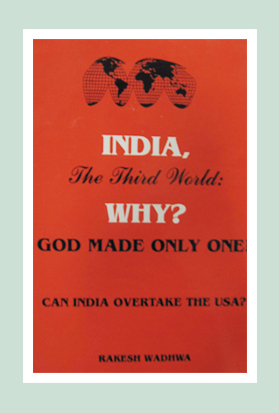Copy China, Not India
The world has woken upto what is happening in China. In the last two years, every international business magazine has done at least one cover story on China. ‘Fortune’ not only put China on the cover in its special October 11, 2004 issue, but devoted the entire magazine to it. ‘Times’ cover had Chinese gymnasts on it in its August 16, 2004 issue. ‘The Economist’ has featured China on its cover in each of the last three months; China’s growing pains were in the August 21-27 issue, September 25 – October 1 featured Chinese leaders, and the November 20–26 reported on China’s growth spreading inland.
Why all this attention? China, in the last century, was largely ignored by the world. The only time the world leaders took note of this country was when it invaded Tibet. Today, any country which ignores China does so at its own peril.
The reason is that China’s 1.3 billion people are beginning to matter. China has become one of the world’s largest market for most goods, it is also one of the world’s principal exporters. China’s demand for oil is insatiable. In 2003, it surpassed Japan to become the world’s largest buyer of oil after the US.
What accounts for its economic clout? The answer lies in the phenomenal growth of the Chinese economy since the 1970’s. In the last three decades China has been growing at 10% per year: This double digit growth has propelled it to the status of an economic superpower.
At a growth rate of 10% an economy doubles itself every seven years. That means in 14 years, the economy quadruples, and in 28 years the economy’s size grows to 16 times of what it initially was. Give the country another 7 years of 10% growth, it will double again becoming 32 times of what it was at the beginning of period from which we are counting.
This is why China which did not count for much in the 1960’s is starting to matter. The evidence of this growth is everywhere. Each major city in China has thousand’s of skyscrapers. Shanghai’s growth puts New York to shame. Shenzhen is growing faster (over 10%) than the growth rate of Singapore and Hong Kong combined. Little heard Chongqing is the world’s largest city with its 31 million people. It is estimated that $200 billion of private capital will be invested in this city alone in the next 10 years.
China has become the world’s trading hub, its exports and imports are growing at a pace at which it is expected to cross the one trillion dollar mark by 2005. Its trade with the US and Japan already exceeds $250 billion.
China has left India far behind. Indians in the 1960’s enjoyed a per capita income which was higher than that of the Chinese. Not any longer. Each Chinese is today, on average, thrice as rich as each Indian.
The difference would have been even greater had India not started to reform its economy and liberalize in the 90’s. It was a case of too little too late for India. If India has to match China, it needs to do far more.
Double-digit growth rates require investment. Huge amounts of it. China understands this, India is just beginning to do so. China gets $50 billion in foreign investment, India aspires to get 10% of that. India will have to do better, much better, it will have to liberalize more, tax less, reform its labour laws, end its reservation policy for small industries, and bring down its inspector and regulatory raj. In other words India would have to become more like China.
Where is Nepal in all this? Unfortunately, it copied India. It needs to stop doing that. Nepal should align itself with the business friendly policies of China and it too will be transformed as China has been. 35 years of even low double digit growth will propel Nepal’s per capita income from its present US$250 to US$8,000 i.e. each Nepali will then earn, Rs.50,000 a month. Wouldn’t that be transformation for real? If this was to happen, Nepal too would attract the world’s attention as China is.
The Himalyan Times
The Chinese Transformation
China today offers us the amazing scenario of a country marching towards economic freedom while remaining politically unfree. Even as the communist rulers of China liberalize their country for business and welcome foreign capital, they maintain their stranglehold on political power.
The result of the loosening of the State’s grip over the economy has been stunning: since 1980, the Chinese per capital income has more than tripled, over 200 million of its people have moved from poverty into middle class, foreign investment has soared to almost US$50 billion exceeding what is invested in India by foreigners by a factor of 20, and it has become one of the world’s principal exporters with its US$350 billion in export of services and goods – beating India’s export by over four times.
Government in China has been slowly but surely reducing its role in the economy. State owned enterprises which accounted for over 80% of the Chinese industrial output prior to 1980 now account for half that figure. This while exports from privately owned companies have skyrocketed. Shenzen, one of China’s dynamic coastal provinces has seen its exports rise from US$17 million in 1980 to US$6 billion in 1991 and today its exports exceed US$35 billion.
This transformation has occurred even as China remains undemocratic; dissent is virtually nonexistent after the Tiananmen square massacre. What this tells us is that however desirable democracy may be for other reasons, it is not indispensable for a country in achieving prosperity and wealth.
Singapore became wealthy under the iron-fisted rule of Lee Kuan Yew. Singapore did not offer parliamentary, electoral, and press freedom to its people as India did. Singapore, however, unlike India and Nepal, gave its people economic freedom soon after the end of World War II. The result: Singapore today is one of the world’s wealthiest economies: its people earn an annual average income of US$27,000.
China’s transformation too is taking place under the iron-hand of its communist rulers. In the first decade of its economic reforms, though China saw mounting political dissent, it was mercilessly quashed: tanks, troops, and bullets were employed in the 1989 attack by the government on demonstrators at Tiananmen.
Economic reforms however continued. Controls on foreign exchange were loosened in the 1990’s leading to the present boom in investments from the US and the rest of the world. Today the world invests more in China than in the US. Stock markets – the prime symbol of capitalism – were set up in Shanghai and Shenzen in the early 90s.
In 1992, the supreme leader of China, Deng Xiaoping, acting more like the free-market Lee Kuan Yew of Singapore than a Maoist, spoke out in favour of the free market policies being followed by the coastal regions of Guangzhou and Shenzen. What happened? All dissent to open market policies was effectively shut up. Who was going to dare speak up against the supreme leader himself? These coastal regions largely freed from bureaucratic red tape and over-bearing controls grew at a sizzling 15% annual rate.
From then onwards there has been no looking back for China. Chinese people, who were at one time called no-good-opium-eaters by their colonial masters, shook the world with their ability to flood every market with goods. The efficiency of Chinese firms makes its competitors quake with fear.
This is not to say that things can’t go wrong in China. The government still exercises controls over vast areas of its economy and that’s where the danger lies. China’s controls over its currency and its inefficient and outmoded State enterprises can lower its growth. Other than that things are good and getting better.
Lessons for Nepal: all it needs is one strong leader who can give the people economic freedom, nothing else is going to make Nepal rich. Democracy and political freedom, important as they may be, are not going to result in Nepal’s progress. That is what we understand from what has happened in China and Singapore over the last few decades.
The Himalyan Times
 Rakesh Wadhwa. Ever since, I was a school boy, I knew India was on the wrong path. Socialism was just not what we needed to get ahead. Government controlled our travel; government controlled our ability to buy and sell; and government controlled our freedom to move our money. My life has focused on the inherent rights people have. When I was in college, I never understood, what the governments meant by their "socialistic attitude". If people are free to buy, sell and move their capital themselves without any restrictions by state, then the welfare of people is inevitable & hence the countries they live in will become wealthy. The government has no right whatsoever, to point a finger at me or my business. I am not a revolutionary. I just want to light up my cigarette and not get nagged about it. I believe in non-interfering attitude to attain more.
Rakesh Wadhwa. Ever since, I was a school boy, I knew India was on the wrong path. Socialism was just not what we needed to get ahead. Government controlled our travel; government controlled our ability to buy and sell; and government controlled our freedom to move our money. My life has focused on the inherent rights people have. When I was in college, I never understood, what the governments meant by their "socialistic attitude". If people are free to buy, sell and move their capital themselves without any restrictions by state, then the welfare of people is inevitable & hence the countries they live in will become wealthy. The government has no right whatsoever, to point a finger at me or my business. I am not a revolutionary. I just want to light up my cigarette and not get nagged about it. I believe in non-interfering attitude to attain more. 
 The Bastiat Award is a journalism award, given annually by the International Policy Network, London. Bastiat Prize entries are judged on intellectual content, the persuasiveness of the language used and the type of publication in which they appear. Rakesh Wadhwa won the 3rd prize (a cash award of $1,000 and a candlestick), in 2006.
The Bastiat Award is a journalism award, given annually by the International Policy Network, London. Bastiat Prize entries are judged on intellectual content, the persuasiveness of the language used and the type of publication in which they appear. Rakesh Wadhwa won the 3rd prize (a cash award of $1,000 and a candlestick), in 2006.
What the readers are saying…